The crisis and threat of war in Ukraine has dominated the headlines for a couple weeks and this morning was no different with Al Jazeera reporting: Nord Stream 2: Why Russia’s pipeline to Europe divides the West. The article details another aspect of the conflict. Here are some key excerpts:
As Western powers attempt to avert a Russian invasion of Ukraine, Nord Stream 2, a long-touted energy infrastructure project that has already driven a wedge between Germany and the United States, could become a key bargaining chip.
The $11bn gas pipeline across the Baltic Sea, owned by Russia’s state-backed energy giant Gazprom, runs from western Siberia to Germany, doubling the capacity of the already-in-use Nord Stream 1 pipeline.
While Germany has maintained it is solely a commercial project, Nord Stream 2 also has geostrategic consequences, bypassing Ukraine and potentially depriving it of the approximately $2bn in transit fees Russia currently pays to send gas through its territory.
Overall, the article does a very good job of covering the pipeline problem for Europe, Ukraine and Russia and it got me thinking about a paper I wrote on Ukraine almost 3 years ago while working on my Master’s Degree. So I figured I would share it here. Long story short, I didn’t think Ukraine should join NATO then, and the events of the last few weeks have not changed my position.
Ukraine, A Country Divided:
What are the Economic Impacts if Ukraine Joins NATO
Since gaining its independence in 1991, Ukraine, a vital component of the former Soviet Union, has increasingly looked toward the west. Ukraine is an economically diverse country that has a long tradition of trading with Russia and has developed significant ties with NATO countries. (Fisher, 2009) Currently the country is divided along ethnic lines and is facing a presidential election that could determine its future. Two of the main issues are the war that is currently being fought against Russia in its Eastern Regions, and should Ukraine join NATO. The decision to join NATO will have far reaching geopolitical effects including how would such a move effect the Nation’s economy? [Figure 1]
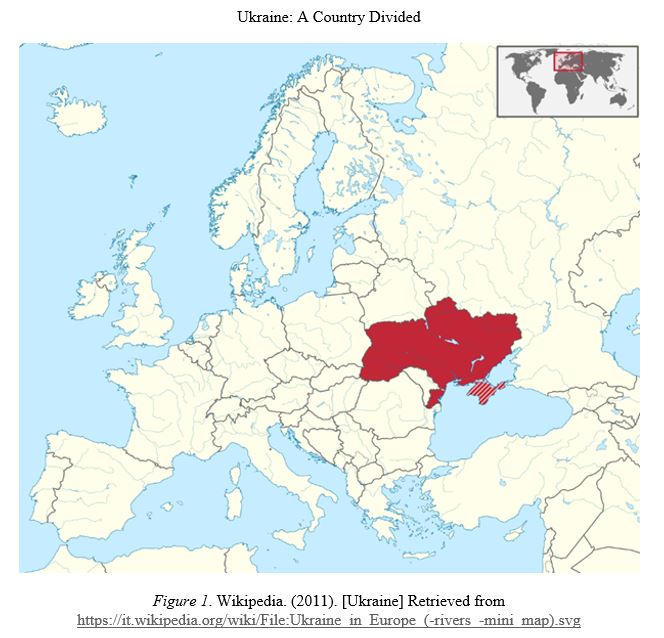
Bottom Line Up Front
Prior precedent has shown there is no cultural argument for Ukraine not joining NATO. Estonia and Latvia represent a similarly diverse culture located on the Russian border and have been members of NATO since 2004. Estonia and Latvia also demonstrate that imports and exports will likely continue as they are mutually beneficial. NATO was established to provide collective security against the Soviet Union and it currently similarly positions itself against the Russian Federation. A Ukrainian move toward NATO will specifically threaten the transfer fees from the sale of Natural Gas from Russia to the rest of Europe. If the demand for natural gas increases as expected, Russia will attempt to avoid Ukraine as such projects will only aid an officially stated opposition force. Ukraine joining NATO will impact trade relations though probably not significantly. Ultimately, Ukraine’s geographically significant location on the Black Sea and proximity to the disputed Crimea and Donbas regions are key to the economic impact of joining NATO. Prior to joining NATO, border disputes are supposed to be resolved so that Article 5 of the NATO Charter is not triggered. An all-out war would be devastating to the economy and a failed state would be a threat to all nations, NATO and Russia alike.
Method
To determine the economic impacts of Ukraine joining NATO this paper will consider the geographic location of Ukraine in relation to Russia and compare it two other NATO countries that share a border with Russia. This paper will use the percentage of a shared border, the percentage of imports from Russia and the percentage of exports to Russia for a determination of how economically dependent each country is to the other. To determine the cultural comparison this paper will use the percentage of a shared border, the percentage of Russian speakers and the percentage of ethnic Russians that reside within each country to establish the similarity of the countries. In addition, an analysis of competing hypotheses will be conducted to determine the economic and cultural impact of NATO membership for Ukraine.
Grounding
Situated on the Black Sea, Ukraine is geographically significant from both a strategic and an economic perspective. [Figure 2] According to F. Stephen Larrabee, a Distinguished Chair in European Security at the RAND Institute, “The emergence of a democratic independent Ukraine transforms the geo-strategic landscape in Central Europe. Without Ukraine Russia ceases to be a Eurasian empire. However, if Russia were to regain control over Ukraine with its 46 million people, major resources and access to the Black Sea, Russia would automatically regain the wherewithal to become a powerful imperial state.” (Taylor, 2014) In addition, Ukraine has a well-developed military industrial complex and if the unrest in Ukraine leads to it becoming a failed state, it could become a “giant bazaar for customers seeking ICBM [intercontinental ballistic missiles] and other deadly technologies.“(Taylor, 2014) These two points highlight the geo-significance of Ukraine and that its decision to join NATO should not be taken lightly. In fact, Ukraine’s strategic importance has also been demonstrated by Russian action in the current low-intensity conflict in the Donbas and in 2014 when Russia seized and occupied Crimea. Crimea is a “strategically important base for the Russian navy. The Black Sea Fleet has been based on the peninsula since it was founded… in 1783. The fleet’s strategic position helped Russia defeat Georgia in the South Ossetia war in 2008, and remains crucial to Russian security interests in the region.” (Mortimer, 2014) When asking the question or deciding if one should support a Ukrainian move to NATO, one must also consider not only the interests of the Ukrainians but the Russians as well.
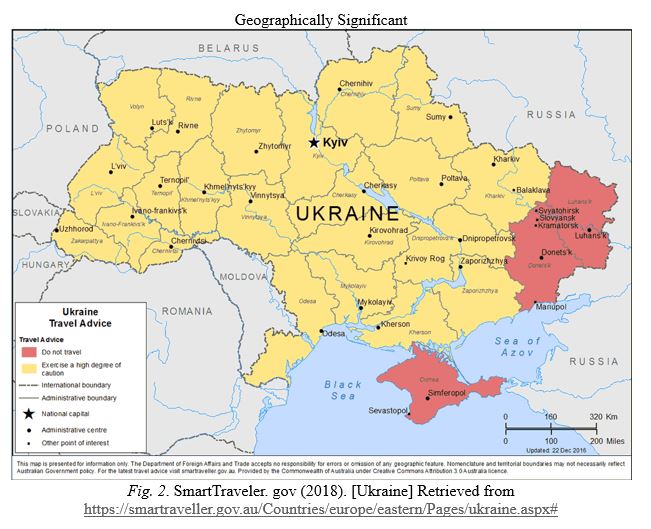
Ukraine is economically strategic due to its access to ports and natural gas pipelines. “A number of key gas pipelines from Russia to Western Europe run through Ukraine. [Figure 3] In pure economic terms, a shift to Russia would likely change the dynamics of how Western Europe is powered.” (Cohen, 2018) According to Ariel Cohen with Forbes, “Ukraine is Russia’s gateway into European gas markets. Of the 193 billion cubic meters (bcm) Russia’s state-owned Gazprom pumped westward in 2017 – nearly 40 percent of Europe’s total supply – 93 billion cubic meters (bcm) transited via Ukraine.” … these “transit revenues contribute some 2-3 billion dollars annually to the Ukrainian economy or roughly 3 percent of Ukrainian GDP. “The vast network of pipelines crisscrossing Ukraine affords Kyiv some geopolitical leverage in its ongoing conflict with Russia, as Moscow needs the uninterrupted revenue stream provided by gas sales to Europe.” (Cohen, 2018)
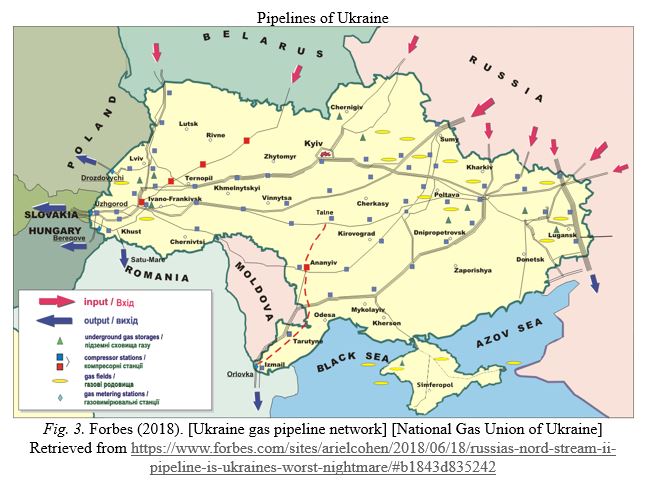
Historically, “After Russia, the Ukrainian Republic was the most important economic component of the former Soviet Union, producing about four times [as that of] the next-ranking republic. Its fertile black soil accounted for more than one-fourth of Soviet agricultural output, and its farms provided substantial quantities of meat, milk, grain, and vegetables to other republics. [In addition], its diversified heavy industry supplied unique equipment…and raw materials to industrial and mining sites in other regions of the former USSR.” (CIA Fact Book, 2019) According to 2017 data obtained from the CIA Fact Book, the Annual GDP of Ukraine in $369.6 Billion with Industry producing 28.6 % of GDP and Agriculture comprising 12.2 % of GDP. While Russia is the largest single trading partner of Ukraine, NATO countries comprise at least 21% of their exports and 23.3% of their imports.
In addition to being economically diverse, Ukraine is a Culturally diverse country. [Figure 4] Although 77% identify as Ukrainian 17.2% identify and as Russian which make up the largest minority group. (Obershev, 2016) These groups are not evenly distributed and are concentrated in the Crimean and far western Donbas regions thereby concentrating tensions on whether Ukraine should become a member of NATO or not in these regions. In 2013, a poll determined “45 percent said they wanted [to join] the EU, 14 percent said they wanted to join with the Russian-led trade union, and 41 percent said they were undecided or wanted neither. In other words, joining the EU is about as popular as not joining the EU. (Fisher, 2013)

NATO: “The North Atlantic Treaty Organization was created in 1949 by the United States, Canada, and several Western European nations to provide collective security against the Soviet Union.” (NATO, 2019) “Since 1949, NATO’s membership has increased from 12 to 29 countries through seven rounds of enlargement. Currently, four partner countries have declared their aspirations to NATO membership: Bosnia and Herzegovina, Georgia, the Republic of North Macedonia and Ukraine.” (NATO, 2019) A 1995 study on how to enlarge NATO required potential aspirants for membership to resolve border disputes prior to joining NATO. (Pifer, 2017) (Brown, 2017) [Figure 5]
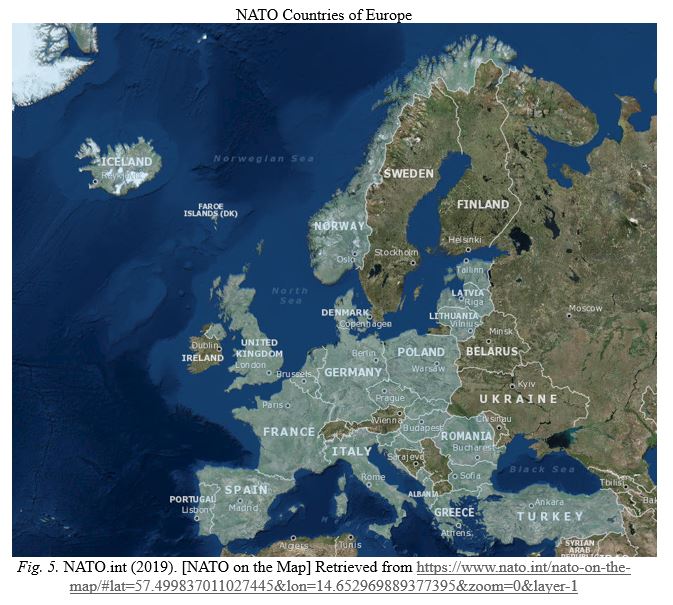
Latvia and Estonia, like Ukraine are former Soviet States that share a border with Russia. [Figure 6] All three countries have a significant portion of their population that speak Russian and identify as ethnic Russians. In addition, all three countries actively trade with Russia and have natural gas pipelines that run from Russia to Europe through their countries. It should be noted that the Russian speakers are concentrated near the borders of Russia in both Estonia and Latvia similar to that which is demonstrated in Ukraine. [Figures 7 and 8]

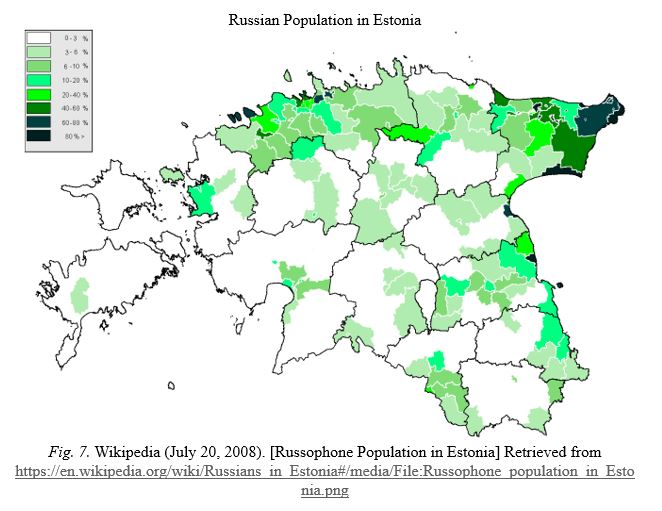
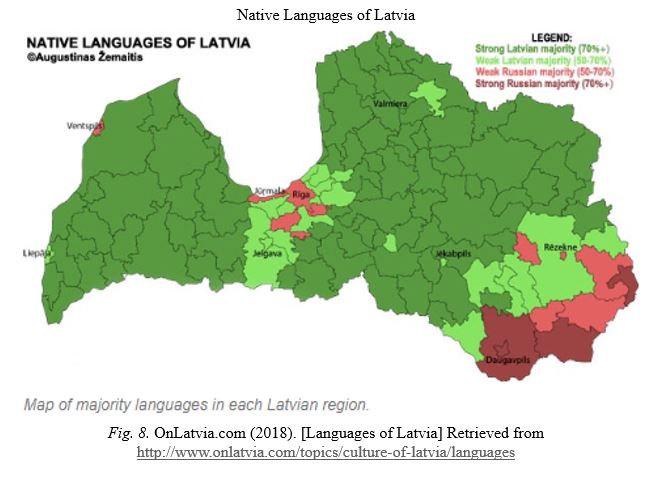
Assumptions
The following is a list of assumptions the we believe will remain true regardless of NATO membership:
- NATO Membership will mean the collective protection of Article 5 in defense of foreign aggression.
- European demand for Natural Gas will remain high.
- Ukraine will continue to be considered militarily strategic.
- The Ukrainian population will continue to be politically and ethnically divided.
Hypotheses
When reading public literature on whether Ukraine should join NATO most articles fall into two camps. That Ukraine should or should not join NATO due to the diverse culture or Ukraine should or should not due to economic interests. We conducted an Analysis of Competing Hypotheses framing the questions in economic and cultural terms. Three hypotheses were created:
- Ukraine’s economy will be negatively affected by joining NATO.
- Ukraine’s social fabric / population will be negatively affected by joining NATO.
- Ukraine joining NATO will have no effect.
In regards to the cultural argument we found the following evidence:
- Ukraine has a diverse population
- Ukraine’s Politics have long been divided into two major factions, pro-western and pro-Russian
- A large percentage of Ukraine borders Russia
- A significant portion of Ethnic Russians are located near the Russian Border
- There is a significant number of Russian language speakers in Ukraine
- Most Ukrainians culturally identify with traditional orthodox Christianity similar to that in Russia.
In regards to the economic argument we found the following evidence:
- Ukraine’s existing economy is more dependent on Russia than on NATO
- Ukraine is dependent on imports of Russian Natural Gas for heat and energy
- Ukraine is a key intermediary for Natural Gas exports from Russia to Europe
- Ukraine’s economy is negatively affected by the closing of the Kerch Straight with provides access to the Sea of Asov
- And Ukraine’s percentage of population below the poverty line is significantly low.
Evaluation
According to data compiled from the CIA Fact Book, Ukraine, Estonia and Latvia have similar profiles in the percentage of total border with Russia, the percentage of Russian language speakers and the percentage that identifies as ethnic Russians. In addition, the percentage of trade with Russia and NATO countries is also compared in this analysis. Estonia shares a larger percentage of border with Russia. Latvia has a larger percentage of the population that speak Russian and identify as ethnic Russians. The Economic Comparison found that Ukraine is more reliant on Russian imports but Latvia is more reliant on Russia for exports. Both Estonia and Latvia have heavy trade imbalances toward NATO countries. [Table 1]
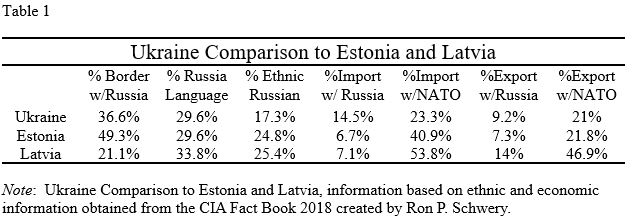
To further compare the three countries, we isolated the raw data into two categories, Population and Economic, and created an equation for comparison. The Population Evaluation multiplied the percentage of a shared border, the percentage of Russian language speakers and the percentage of the population that identify as ethic Russians. The Economic evaluation was figured in a similar manner where the percentage of a shared border, and the percentage of Imports and Exports with Russia were multiplied. Each equation was then multiplied by a factor of 100 for display purposes. Estonia more closely identifies culturally with Russia and Ukraine’s economy is more reliant on trade with Russia. Interestingly, the percentage of the population that is considered as below the poverty line was also noted from the information obtained from the CIA fact book. This information was not factored into any equation but it could indicate an overall health of the economy. Ukraine’s percentage of the population was noted as significantly lower than both Estonia and Latvia. [Table 2]

The results of our analysis determined that in terms of culture, the negative effect of Ukraine joining NATO is inconclusive or will have no effect. Our determination was primarily based on the precedent set by Latvia and Estonia joining NATO in 2004. We determined that culturally, Ukraine is not dissimilar to either country and even though there is a large concentration of ethnic Russians that reside near the Russian border this is not dissimilar to both Estonia and Latvia. [Table 3]

We determined that the economic results of our analysis of should Ukraine join NATO is conclusive, it will impact the economy negatively but the results are mixed. Ukraine’s overall economy is more dependent on Russia than our comparison countries but their total exports are greater to NATO countries. It could be argued that joining NATO will open markets to the west and increase these exports. This argument however is mixed due to the potential of fewer exports to Russia and that the markets are already opened to the west as demonstrated by a greater overall total of existing trade toward NATO countries. In addition, Ukraine’s low percentage of population below the poverty line can be argued for or against joining NATO by noting that the low percentage could absorb the economic shock created by a geopolitical realignment or that the already diverse balanced economy creates a more stable economy and lower percentage of the population below the poverty line.
Findings
All three of the countries that we examined are largely dependent on Natural Gas imports from Russia. [Figure 9] Ukraine does produce some natural gas but not enough to sustain themselves. Each of the three surveyed countries contain Russian sourced Natural Gas Pipelines. However, nearly 40% of all Russian exports move to Europe through Ukraine. As reported earlier, the transit revenue generated by the Natural gas pass through contributes 2-3 billion annually to the Ukrainian economy or roughly 3 percent of GDP.

While Estonia and Latvia have provided an important perspective on what NATO membership would mean in regards to common borders, a diverse concentrated population near the border; and trade practices, they do not indicate that NATO membership will irreparably harm trade with Russia. However, Latvia and Estonia are not the perfect examples of what it would mean or the economic impact for Ukraine to join NATO. Simply put, Ukraine is different. There are differences and those differences may outweigh any determination from our evaluation. [Table 4] Some of the key differences include:
- Ukraine is much larger in area and population.
- The economy is significantly more important in terms of overall production.
- And perhaps most importantly the difference in Time and Place. Estonia and Latvia joined NATO soon after the fall of the Soviet Union and Russia most likely could have done little to stop it.

Russia is once again trying to project power beyond its border and Ukraine has been right in the middle with Russia seizing Crimea in 2014, the nearly 2-year-old conflict in the Donbas and the recent incident in Kerch Strait.
The Kerch Strait is a 25-mile-long channel that is no wider than 9 miles. [Figure 10] It is of strategic importance in that it controls water routes and energy resources for both Russia and Ukraine, linking the critically important Black Sea to the Sea of Azov off of Russia’s Northern Caucasus border. “Access to the Sea of Azov is something the Russians must keep locked into their sphere as it has direct access to the Don River, which cuts Russia completely from the Caucasus to Ukraine — keeping the West away from that pressure point is imperative for the Russians in order to keep any control in the Caucasus.” (Stratfor, 2008)

In addition to the Kerch Strait, “Ukraine today is involved in an undeclared, low-intensity conflict with Russia in the Donbas. The Kremlin has organized, led, funded, armed and otherwise supported…violent separatism in Donetsk and Luhansk of a kind that Russia itself would never tolerate…. Even if the Donbas conflict were settled, there would remain the issue of Crimea and its illegal seizure, occupation and annexation by Russia…Until the simmering conflict in the Donbas and frozen conflict in Crimea are resolved, Ukraine has little prospect of [NATO] membership.” (Pifer, 2017)
In addition to strategic importance, Natural Gas is an economically vital Russian export. Ukraine provides a vital Natural Gas pass through to the European Market and Russia will play a role in the outcome whether it is through internal political pressure, economic retaliation or even war. Currently, Russia is in the process of building the undersea Nord Stream II Natural Gas Pipeline that bypasses Ukraine by running under the Baltic Sea. [Figure 11] By bypassing Ukraine, Russia will not have to pay or more accurately, Ukraine will not be able to collect the transfer fees threatening nearly 3% of their annual GDP.

References
ArcGIS.com. 2019. Ukraine, Estonia, Latvia, March 11. https://pennstate.maps.arcgis.com/home/webmap/viewer.html?useExisting=1Brown, (March 11, 2019)
Bandow, Doug. 2018. Ukraine Should Not Be a Member of NATO, The National Interest, November 27. https://nationalinterest.org/feature/ukraine-should-not-be-member-nato-37287 (February 14, 2019)
Brown, Daniel. 2017. This is what would happen if Ukraine joined NATO. Business Insider, July 10. https://www.businessinsider.com/this-what-would-happen-ukraine-joined-nato-2017-7 (March 11, 2019)
Chossudovsky, Michel. 2018. Strategic Waterways and “The Kerch Strait Incident”: Towards Military Escalation? GlobalResearch.org, November 26. https://www.globalresearch.ca/strategic-waterways-and-the-kerch-straits-incident-a-towards-military-escalation/5661045 (March 11, 2019)
CIA Fact Book, (2019) Ukraine, Estonia, Latvia, Russia, Poland, https://www.cia.gov/library/publications/resources/the-world-factbook/geos/up.html (February 14, 2019)
Cohen, Ariel. 2018. Russia’s Nord Stream II Pipeline Is Ukraine’s Worst Nightmare, Forbes, June 18. https://www.forbes.com/sites/arielcohen/2018/06/18/russias-nord-stream-ii-pipeline-is-ukraines-worst-nightmare/#b1843d835242 (March 6, 2019)
Fisher, Max. 2009. This one map helps explain Ukraine’s protests. The Washington Post, December 9. https://www.washingtonpost.com/news/worldviews/wp/2013/12/09/this-one-map-helps-explain-ukraines-protests/?utm_term=.5a1efd98cef5 (February 14, 2019)
Gwertzman, Bernard. 2019. The Business and Politics Behind the Russia-Ukraine Gas Dispute.” Council on Foreign Relations, January 9. https://www.cfr.org/interview/business-and-politics-behind-russia-ukraine-gas-dispute (March 6, 2019)
Mortimer, Caroline. 2014. Ukraine Crisis: Why is Crimea so important to Russia? UK Independent, March 3. https://www.independent.co.uk/news/world/europe/ukraine-crisis-why-is-crimea-so-important-to-russia-9166447.html (February 14, 2019 )
North Atlantic Treaty Organization. 2019. Enlargement, February 15 . https://www.nato.int/cps/ie/natohq/topics_49212.htm (February 15, 2019)
Obershev, Caroline. 2016. Major Ethnic Groups of Ukraine, WorldAtlas.com, May 25. https://www.worldatlas.com/articles/major-ethnic-groups-of-the-ukraine.html (February 14, 2019)
OnLatvia.com. 2018. Languages of Latvia. http://www.onlatvia.com/topics/culture-of-latvia/languages (February 14, 2019)
Pifer, Steven. 2017. Will Ukraine join NATO? A course for disappointment. Brookings, July 25. https://www.brookings.edu/blog/order-from-chaos/2017/07/25/will-ukraine-join-nato-a-course-for-disappointment/ (February, 15, 2019)
Radio Poland. 2018. Two-thirds of Ukrainian voters would back NATO membership:poll. Radio Poland, December 9. http://www.thenews.pl/1/10/Artykul/382126,Twothirds-of-Ukrainian-voters-would-back-NATO-membership-poll (February 14, 2019)
SmartTraveler. gov. 2018. Ukraine https://smartraveller.gov.au/Countries/europe/eastern/Pages/ukraine.aspx# (March 8, 2019)
Stratfor.com. 2008. Ukraine, Russia: The Importance of the Kerch Strait. Stratfor WorldView Assessments, November 10. https://worldview.stratfor.com/article/ukraine-russia-importance-kerch-strait (March 11, 2019)
Taylor, Adam. 2014 Why Ukraine is so Important, Business Insider, January 14. https://www.businessinsider.com/why-ukraine-is-so-important-2014-1 (February 14, 2019)
Wikipedia. 2011. Ukraine. https://it.wikipedia.org/wiki/File:Ukraine_in_Europe_(-rivers_-mini_map).svg (February 14, 2019)
Wikipedia. 2008. Russophone Population in Estonia, July 20. Retrieved from https://en.wikipedia.org/wiki/Russians_in_Estonia#/media/File:Russophone_population_in_Estonia.png (February 14, 2019)
World Atlas.com. 2018. Major Ethnic Groups of Ukraine. https://www.worldatlas.com/articles/major-ethnic-groups-of-the-ukraine.html (February 14, 2019)
Young, Thomas. 2015. 10 maps that explain Ukraine’s struggle for independence, Brookings, May 21. https://www.brookings.edu/blog/brookings-now/2015/05/21/10-maps-that-explain-ukraines-struggle-for-independence/ (February 14, 2019).

